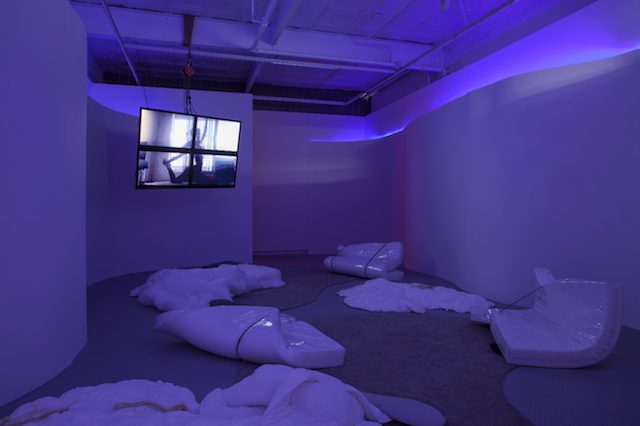Arsenal Contemporary, New York, 3 May – 2 July
During the performance at her new solo show, British artist Hannah Perry is seen sitting on the floor, hunched over her laptop and typing while smoking a cigarette. In the dark room around her, a group of performers bounce off contorted white blobs in plastic and foam scattered on the ground, momentarily enacting postures of affect such as longing, despair, anger and desire.
The lonely girl behind the computer crystallises as the authorial voice of Viruses Worth Spreading, a postbreakup journey spanning painting, sculpture and video, and mapped through the many arbitrary traces of contemporary online life (including but not limited to updating, stalking, liking, blocking, streaming and chatting). Perry’s obsessiveness unfolds as a porous encounter with the world in both virtual and material terms, tracking the textual and material manifestations of human emotion onto familiar industrial materials. A series of prints on Plexiglas and aluminium (A Phone Full of Friendzones, Size Queen, Hey Papi, all works 2017) greet the viewer along the wall of the gallery. They consist of collaged snippets of personal text messages; fragmented, sized-up iPhone images; and various other online vernaculars. Summer of Blocking textually archives on Plexiglas spiralling threats against an estranged lover, ultimately ending with the statement ‘block myself’. The deeply personal and even diaristic is here always already mediated digitally, and seemingly only registered once communicated and distributed as data, where, in the flow of Internet traffic, it is destined to become a little less generic than a meme.
Feelings such as obsession, despair and distraction are typically categorised as irrelevant, self-indulgent and unproductive, particularly when given voice by women. In the spirit of Chris Kraus and many other female auto-theorists, Perry seeks productivity in the purposely forceful performance of the ‘hysterical woman’, where emotion is accelerated and multiplied into incoherence. Two sculptural works, Pretty and Trauma Junky, aestheticise the rush of a car-crash by incorporating broken car parts into a sculptural entity, translating perhaps the longing for extremities of pleasure, danger and excitement when one is sick with a broken heart. The four-channel video Cry Daggers extends this strategy to the moving image, loudly juxtaposing sexualised music videos with personal recordings of drunken taxi rides and West Coast roadtrips, while an animated text document, with stream-of-consciousness-type musings addressed to Him, to the world and to no one in particular, endlessly expands on screen.
These artefacts of affective labour are, if anything, the bridge between Viruses Worth Spreading and Perry’s longer-standing interest in so-called working class aesthetics, in which, as the press release of this exhibition also asserts, ‘abstract entities [are] synthesized under the umbrella of culture and ritual’ in her native Northwest England. These entities, united in a series of floor-based sculptural works in the darkened middle room of the gallery, seem to include synthetic hair-extensions, steel and the same plastic-wrapped duvets that served as props for Perry’s performance. A portrait of the poor? Outside the artist’s own biography, it ultimately feels difficult to connect Perry’s recent heartbreak with the socioeconomic realities of working-class England.
From the Summer 2017 issue of ArtReview
